Contents


Fresh fragrant basil is the most popular and exquisite spice used in cooking. In order to enjoy fragrant greenery all year round, many housewives grow basil on the windowsill in the cold season. Basil is a versatile seasoning that pairs well with fish and meat dishes. Fresh spicy greens can be added to salads, marinades, sauces to give a unique taste and aroma. Basil contains many useful vitamins and minerals, as well as phytoncides and esters, widely used in medicine. Basil is an unpretentious plant, therefore, under the right conditions, even an inexperienced housewife will be able to grow this spice at home.
What materials will be needed
Growing basil is possible not only in store-bought soil, but also in ordinary soil taken from the garden. Only in this case, mineral fertilizers specially designed for vegetable crops will have to be added to the soil. In order to grow basil in an apartment, you will need the following materials and supplies:
- high-quality soil – a universal mixture is suitable for basil, which is sold in specialized flower shops;
- seeds;
- planting containers – if the subsequent transplantation of seedlings into pots is expected, then small plastic glasses or other unnecessary containers can be used, but if the plants are not transplanted, then the seeds are planted in large containers with holes to remove excess liquid: flower pots, plastic containers;
- drainage;
- watering can for watering basil;
- water sprayer for spraying plants.
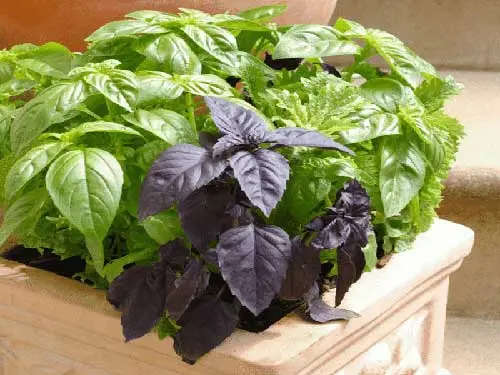
Choosing a type of basil
In nature, there are about two hundred species and varieties of basil, but only a few (no more than ten) of them are popular and used for food. For growing in pots on the windowsill of the house or on the balcony, decorative undersized varieties of basil are better suited:
- Marquis is a small-leaved mid-early variety, a compact, decorative bush, most often of a spherical shape;
- Clove – an ornamental green variety with a tart taste and aroma of cloves with laurel, forms a spherical bush in a pot;
- Dwarf – a low (10-20 cm) decorative variety with a slightly spicy and spicy taste, a small-leaved, spherical bush, sometimes green and purple;
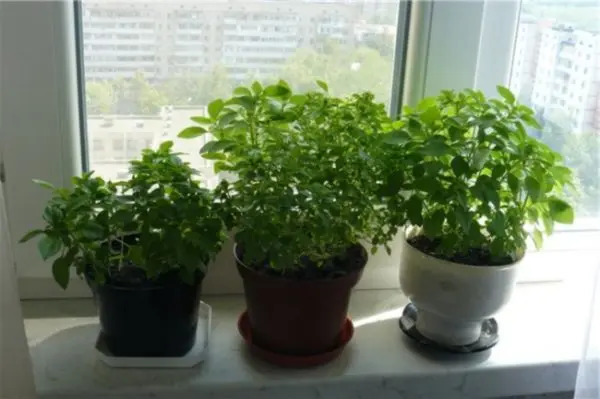
- Lemon – a rather rare variety with light green leaves and a strong lemon aroma;
- Yerevan – undersized variety with purple-blue leaves, spicy taste and aroma of pepper with tea;
- Violet – a large-leaved ornamental variety with a delicate taste and purple-violet leaves – a great decoration not only for a salad, but also for a windowsill.
You can choose a variety of basil according to the speed of ripening. Of the above varieties, the early ones include: Clove, Lemon, Dwarf.
Video “How to grow basil at home”
Video instruction with useful tips and recommendations for planting basil at home.
Soil preparation
If the cultivation of basil at home on a windowsill or balcony will take place in a ready-made universal soil mixture, then no preliminary soil preparation is required, since the ready-made mixtures already contain all the necessary fertilizers. The only thing left to do is to place a layer of drainage on the bottom of the tank, and then fill up the soil. If the land is taken directly from the garden, then before growing basil on the windowsill, it must be enriched with minerals. The soil intended for planting basil seeds should be light, fertile, with a good permeable structure. Such a soil can be prepared from the following components:
- peat, humus and earth in equal parts – all components of the mixture must be mixed well;
- 2 parts of humus and 1 part of coconut fibers;
- 1 part of humus, 2 parts of peat – such a substrate must be supplemented with urea, superphosphate and potassium sulfate;
- 2 parts earth and 1 part fresh compost.
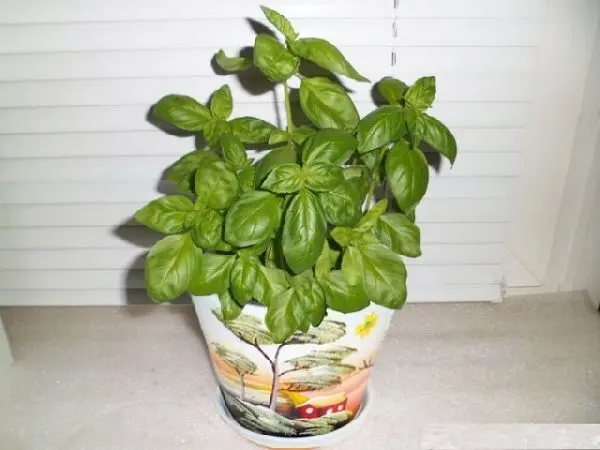
Some gardeners recommend that garden soil, taken for planting plants at home, be calcined in the oven for 20 minutes on a metal baking sheet (pallet), then fill it with complex mineral fertilizers. Growing basil is impossible without drainage – constantly being in moist soil, the plant will hurt and grow poorly. Drainage (expanded clay, small pebbles) can be two-thirds of the total soil volume, but not less than 2-3 cm.
Planting seeds in the ground
The seeds of almost all spicy herbs germinate for a long time and sprout slowly. This is due to the presence of a dense shell containing essential substances. Therefore, before planting basil seeds, you need to keep them in a warm place for some time (1-2 weeks) – warm them up, then soak them for a day with warm, but not hot water. Basil seeds are planted in moist soil to a depth of no more than 1 cm. Several seeds can be sown in one hole for safety – if they all germinate, the weakest sprouts will need to be removed. If the seeds are planted in rows in long boxes, then the distance between them should be approximately 5 cm.
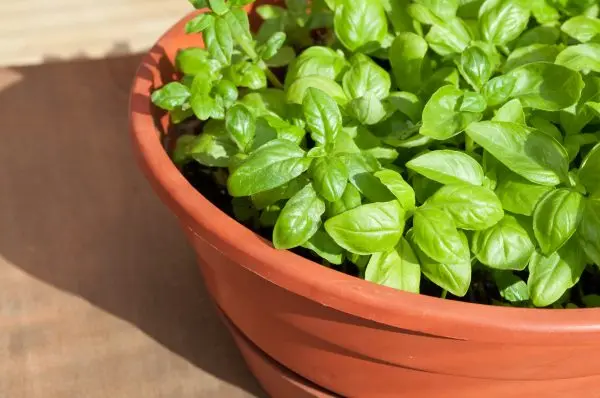
Care and harvest
To obtain basil shoots, heat and light are needed, so pots with planted plants should be covered with a film, placed on a windowsill or on a balcony, and make sure that the temperature under the film does not fall below 22-25 degrees. Every day, the film should be removed for a few minutes to air.
Approximately in the second week after planting the seeds, the first shoots begin to appear. At this time, the film can be gradually removed, and the temperature can be lowered to 20-22 degrees. Basil does not tolerate drafts – this must be taken into account when placing pots with seedlings on the balcony.
Basil is a very photophilous crop, and without sufficient heat and light, its cultivation at home is impossible. But how to grow basil on the windowsill if the windows of the house face north, and also in winter, when daylight hours are very short? In this case, you will need additional lighting with the help of special lamps or other lighting devices. Basil needs at least 15 hours of light daily to grow normally. If it is impossible to provide such conditions, it is better to sow the spice no earlier than February.
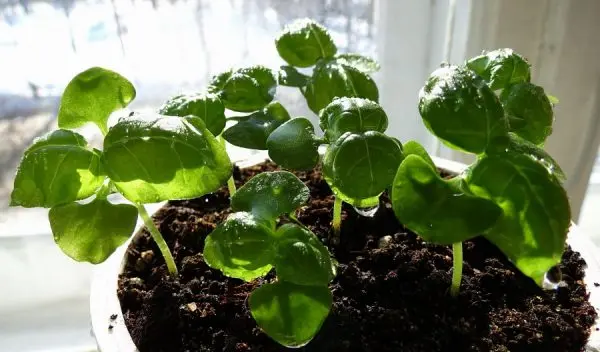
Further cultivation and care of basil at home consists in regular watering and loosening the soil. Young plants should be watered daily in the morning, in extreme heat, you can additionally water in the evening. Water for irrigation should be relatively warm (about 30 ° C). Loosening is carried out 1 time / 2 weeks. With the advent of lateral shoots, the plants must be fed with an organic complex mixture.
After a few weeks, the young plant will turn into a fragrant bush, from which you can harvest the first crop. For use in food, it is recommended to pluck the tops of young shoots. So the plant will branch better and will not be able to bloom – a blooming basil bush is unsuitable for consumption.
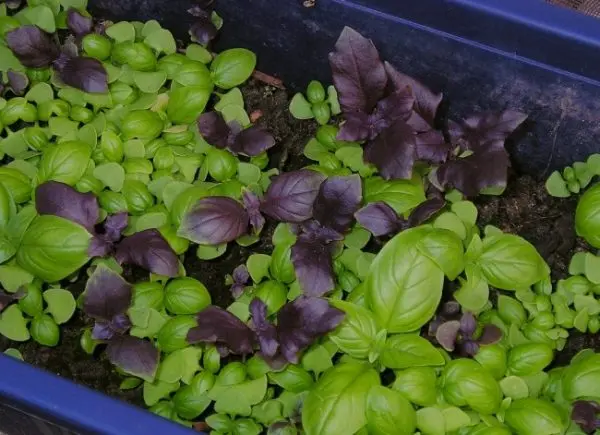
Video “Detailed information about the plant”
Informative video with useful and detailed information about the plant.
Author: Svetlana Galitsina
Loading…









